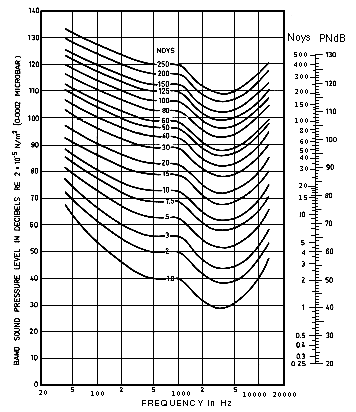A scale developed originally by K.D. Kryter in 1959 to attempt to measure the perceived noisiness of jet aircraft by observers on the ground. The scale has been adopted by the International Standards Organization for international use.
As jet engines were perceived to be noisier than propeller aircraft because of differences in the SPECTRUM of the noise they produce, the method followed a similar approach to LOUDNESS summation of COMPLEX TONEs. Using EQUAL LOUDNESS CONTOURS, Kryter converted the decibel scale into a series of increments, to which he gave the unit of the NOY. From the chart at the right of the graph, the noy scale can be converted into PNdB. The equation expressing this relationship (analogous to the relation between the PHON and SONE) is:
The DECIBEL scale at the left of the graph is for FLAT response. In converting decibels on the A WEIGHTING NETWORK to PNdB, a very rough method is to add 12 dB; thus 100 dBA = 112 PNdB. The tendency at present is for many airports 'theoretically' to accept 110-112 PNdB for daytime flights and 100 PNdB for night flights; but these limits are more generally theoretical than actual, and they are still very high.
See also: EFFECTIVE PERCEIVED NOISE LEVEL, NOISE AND NUMBER INDEX, NOISE EXPOSURE FORECAST. Compare: COMMUNITY NOISE EQUIVALENT LEVEL, NOISE LEVEL, NOISE POLLUTION LEVEL, SOUND LEVEL.
The exact method of calculating noys is analogous to that of loudness index summation described under LOUDNESS and Appendix F. See also: LOUDNESS LEVEL.

Contours of perceived noisiness (from ISO recommendation R507, 1966).
Ref.: K.D. Kryter, "The Meaning and Measurement of Perceived Noise Level," Noise Control 6:5, Sept.-Oct., 1960, pp. 12-17; K.D. Kryter, "Scaling Human Reaction to Sound from Aircraft," Journal of the Acoustical Society of America, vol. 31, 1959, p.1415; I.S.O. Recommendation No. R507.
home